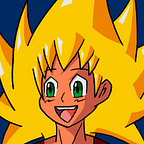Dreamcast Game #12: Jet Set Radio
ジェット セット ラジオ, Jet Grind Radio in the NA release + Jet Set Radio Future
I’m DJ Samurai Cory, and today we’re reviewing another Dreamcast game … Jet Set… Jet Set… J.S.R.! (groovy!) JET SET RADIO!!!
It is also titled Jet Grind Radio for North American players due to trademark problems for “Jet Set” in the United States and Canada at the time. It was released on June 29th, 2000 in Japan, then Halloween 2000 for North American players, and November 24th, 2000 for European players. The player controls a member of a youth gang, the GGs, as they use inline skates to traverse (the real world) Tokyo, spraying graffiti and evading authorities. Jet Set Radio and its sequel Jet Set Radio Future were developed by Smilebit before being merged with Sega R&D in 2004.
Please remember: Don’t try to tag public places in real life. Graffiti is art. However, graffiti as an act of vandalism is a crime. Every state/province (in the case of Japan, wards) has vandalism laws that apply to graffiti, and local and global entities such as cities and countries have anti-graffiti ordinances. Violation of these laws may result in fines, jail sentences, probations, or incarceration. Shinkansen Retrogamer does not condone the real-life act of vandalism in any form.
The graffiti-aggressive inline skating game puts in the shoes of a member of a gang of graffiti-tagging inline skaters called the GGs (short for Graffiti Gang), set in the fictionalized version of real-life Tokyo. The game consists of three types of levels: Street, Rival Showdown, and Trial. The Street levels come in two categories. The first is to tag every graffiti point in each area previously tagged by a rival gang before the timer runs out while evading the authorities. The second category serves as a boss battle by chasing the rival gang members and spraying graffiti on them. The more graffiti points are sprayed, the more deadly the authorities become. Graffiti points are marked by arrows and require paint to tag them. Players can spray graffiti by either pressing a single button or inputting commands using the analog stick depending on the size of the graffiti spot. Players are unable if they run out of paint and must be refilled by obtaining yellow and blue spray cans scattered across the stage. Yellow spray cans refill a single spray can and blue spray cans refill five. Enemies will pursue players and attempt to deplete their health. Health can be replenished by obtaining red and green spray cans. Performing tricks add bonus points to the player’s overall score and gain access to areas difficult to reach.
The game’s composers are Hideki Naganuma, Richard Jacques, and Tomonori Sawada. Sawada was not involved in Jet Set Radio Future. Details about that video game later…
Development was headed by director Masayoshi Kikuchi, with art by Ryuta Ueda. The influence was drawn from late 90s Japanese pop cultures such as the rhythm game PaRappa the Rapper, and the anti-establishment themes in the film Fight Club. The environments were based on Tokyo shopping districts in Shibuya and Shinjuku, with graffiti designed by artists including Eric Haze. It was the first game to use a cel-shaded art style, developed in response to the team’s disappointment towards Sega games mainly resembling anime or manga.
The settings were inspired by Japanese locations such as the Tokyo shopping districts of Shibuya and Shinjuku, which Smilebit photographed to use as references. Sega feared that the game’s style might alienate players outside Japan and requested changes for the international versions. The team added stages modeled after New York City: one based on Times Square, and another on Roosevelt Avenue along Queens and Brooklyn, and changed the nationality of the two characters to American. The interactive credits sequence of the Japanese version was also cut, as localizing it would have meant rebuilding the stage with English names. Sega sold the international version in Japan as De La Jet Set Radio. Ueda was unhappy about the changes, which he felt diminished the essential Japanese elements of the game.
The Jet Set Radio soundtrack includes original and licensed tracks with a variety of genres including J-pop, hip-hop, funk, electronic dance, rock, acid jazz, and trip-hop. The North American version and international rereleases add metal songs. The 2012 port omits “Yappie Feet” and “Many Styles” for licensing reasons. The music has been described as energetic, rhythm-heavy, defiant, and multicultural.
Next up is Jet Set Radio Future, which is an early 2002 original Xbox exclusive. It is known in North America and Europe as JSRF: Jet Set Radio Future (stylized in all caps and often shortened to JSRF). Unlike the first game, Corn (Tab in the overseas versions of JSR) is the leader of the GGs, replacing Beat (the main protagonist of the first game), and he becomes an unlockable character. DJ Professor K, now has gray hair instead of the black flying dreadlocks in the first game, of the fictional Jet Set Radio pirate radio station, broadcasts to gangs of youths who roam the streets of Tokyo-to, skating and spraying graffiti.
There are YouTube videos of playthroughs of both games, many of which had to skip some of the songs that are in both games due to copyright troubles with the musicians’ and the (former) bands’/group’s labels.
Smilebit would call it quits in 2004 after the development of the second game. The game’s two main characters, Beat and Gum, appear as playable characters in the games Sega Superstars Tennis and Sonic & All-Stars Racing Transformed.
That finishes the article for good.
